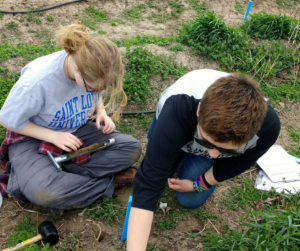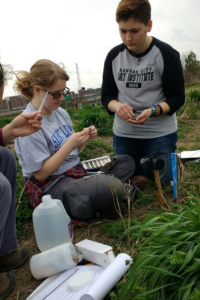No-Till Proposal by Dig It STL

Dig It STL Interns ask: “Why are you tilling the Farm beds?”
Since October, Dig It interns Adam and Anna have been hard at work on the Gateway Greening Urban Farm. From researching and creating a crop rotation plan for the coming year, to getting outside and performing hands-on tasks, they’ve been an incredible help this spring.
As Adam and Anna have learned about soil structure and different soil management practices during their internship, they asked Teen Program Coordinator Carolyn Cosgrove-Payne: “why do we till the vegetable beds on the Gateway Greening Urban Farm?” As an urban agriculture organization, Gateway Greening teaches about no-till practices in our curriculum and discuss the benefits of no-till for microbial activity, soil fertility, and carbon sequestration.
However, we have never tried using no-till soil management practices on our own urban farm. When challenged with the question, the staff thought about it and realized the main reason we haven’t tried no-till is… inertia. Gateway Greening has never directly used no-till and things seemed to be working fine, so it never entered our minds.
As part of the Dig It school-year program, interns are required to complete a culminating project that demonstrates some of the knowledge they gained during their time with Gateway Greening this spring. We are excited to announce that Adam and Anna have chosen to put forth a No-Till Proposal for the Gateway Greening Urban Farm as their culminating project.
Gateway Greening No-Till Proposal by Anna Dotson (McKinley High School) and Adam Mancuso (Collegiate School of Medicine and Bioscience)
Traditional farming practices utilize tilling when preparing to plant new seeds in the ground. This is done in several ways, from large machinery to handheld tools, bu the goal is the same: to loosen and aerate the soil in order to make it easier to plant and introduce nutrients. However, this process also interrupts the natural soil building process that is occurring during the growing season. This is why some farmers choose to instead use no-till practices on their farms, to maintain and boost this process. While till farming builds up the soil (using compost, fertilizers, etc), tears it down, and builds it up again, no-till farmers instead continuously build up the soil throughout the year. We will be testing out no-till farming on the Gateway Greening Urban Farm this season in three different beds- lettuce, okra, and butternut squash. The process we will use on those beds is as follows:
- Use a crimper to crush the stems of the cover crop

- Use tarps to cover the no-till beds and smother remaining cover crops (1-2 weeks)
- Add 4 inches of mulch during initial seeding of bed
- Remove perennial roots from soil where seeds are being planted
- Incorporate dead vegetation back into the mulch
- Pull mulch away from stems of young growing plants
- Add more mulch as plants grow
- Spread compost around plants before adding more mulch on top
- Water beds minimally using drip irrigation
- Educate visitors: “Don’t compact the soil my dudes!”
Before and after the beds are planted, we will be measuring several aspects of soil health through soil testing (pictured in attached pix), and we will compare tilled and no-till beds of the same crops for diseases, pests, and yield throughout the season.


